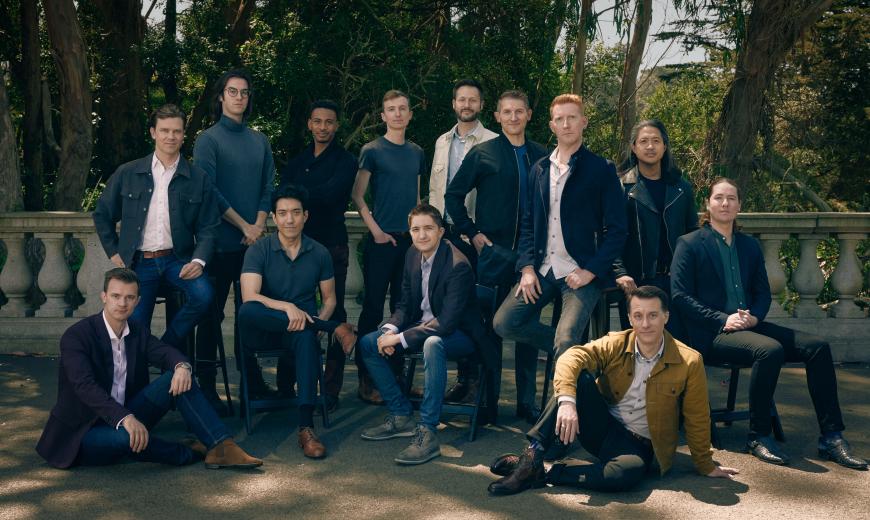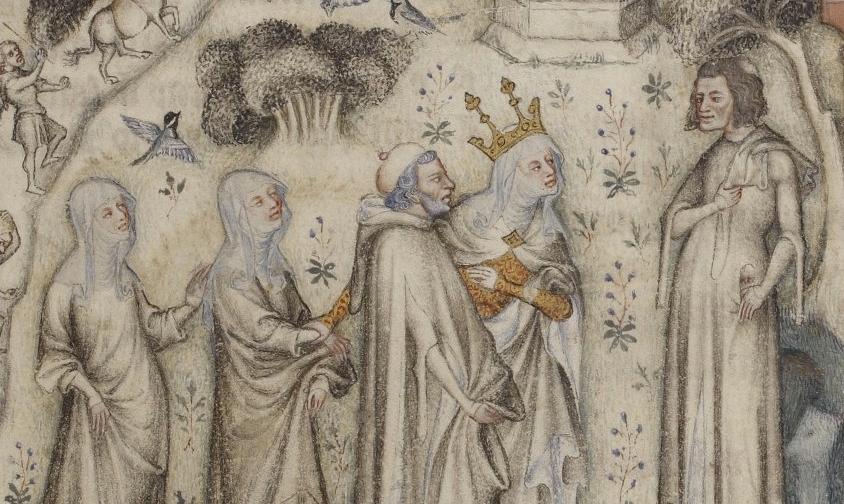
“It’s early music, but you almost have to approach it with a new-music sensibility.”
That’s what’s challenging for countertenor Tim Keeler and the Grammy Award-winning men’s vocal ensemble Chanticleer about Guillaume de Machaut’s Messe de Nostre Dame. But it’s also what will prove exciting about their presentation of the work at a variety of churches around the Bay Area and in Sacramento in early June.
“Chanticleer is known for singing Renaissance music,” notes Keeler, who curated this program and has been the ensemble’s music director since 2020. He says he’s eager to explore earlier music, “and Machaut [c. 1300–1377] fits the bill as truly medieval. Which means [composers then] weren’t as concerned with the later rules of counterpoint of someone like [Giovanni Pierluigi da] Palestrina. So there’s a lot of really wild harmonies that you would get docked for in a counterpoint class today. And a lot of gnarly voice leading where you’re leaping up a seventh into a dissonance.”

Aside from his experimentation, Machaut is celebrated in Keeler’s program notes as “the first composer for whom we have a cohesive repertory” and for creating, with this Mass, “the first large-scale work in the Western musical canon.” Keeler explains, “Structuring anything like that and putting it all together was a big undertaking. And I make a big point of how Machaut used meter as a cohesive force, which hadn’t really been done before. It meant that he could have different voices singing at the same time and playing off of one another in intricate ways that not only added interest to the vocal lines but also to the texture and the structure.”
Although Chanticleer, now in its 46th season, performed this Mass in 1995 on a program with motets by one Machaut’s Italian contemporaries, Francesco Landini, Keeler distinguishes this program as the group’s first to fully showcase the impressive breadth of Machaut’s oeuvre. “It sits in a range that works really well for Chanticleer, obviously written for countertenors, tenors, and basses. We’re splitting his Mass into two sections. We’ll start with the Introit, which is a chant, then go into the Kyrie and Gloria and then take a little break and look into Machaut’s secular work with three sets of chansons [polyphonic songs] in small ensemble, a very different vibe from the Mass. Then we’ll return to the Credo, Sanctus, Agnus Dei, and Ite, missa est. … A lot of [interpreting this music] has to do with text, particularly in the secular music, and our diving into what we’re singing about … how you are moving your body, your facial expressions, the tone of your voice.
“There’s certainly much more experimentation in [Machaut’s] secular music. In the motet, there are three parts, and each is singing a different line of text at the same time, which is incredibly confusing — though there’s evidence that occasionally this would happen in a Mass, where somebody would interject a melody from another text. They didn’t have parts lined up on a score back then, so a lot of the part-writing is obviously linear. You have things that are supposed to happen at the same time but don’t really make sense together.”

Self-promotion seems to have been a particularly successful form of experimentation for Machaut after he survived the Black Death and settled in the northeastern French city of Reims in middle age. “It’s obvious that he thought highly of himself,” comments Keeler. “I wouldn’t accuse him of hubris in creating all those forms, but to take art forms and put your stamp on them takes a lot of guts. There may have been other people at the time who did the same things, and maybe he wasn’t always the first, but he was the first to make known to everyone else that he was doing these things, in part by collecting his works.”
In a masterful meta move, Machaut positioned himself as the central character in four ballades that he “published” in an illuminated manuscript, which depicted Machaut receiving inspiration and counsel from Nature and her three children, Meaning, Rhetoric, and Music.
Machaut wouldn’t have called himself a composer. “The word didn’t come into play until the 1500s really,” Keeler says. “You were paid to be a singer, not a composer or music director.” But Machaut was a prolific poet, with many of his lyrics rhapsodizing on the concept of courtly love.
“‘Certes, mon oueil,’ which is one of the first songs on our program, talks about how ‘My eye has seen rich beauty,’ which is a very physical thing,” notes Keeler. “In every program we sing — any style, any genre, any time period — acting it out in performance is 50 percent of what we do. And there are so many ways to manifest courtly love in your presence, as well as in your voice. Neither Old French nor French Latin is my first language, but part of what makes [these works] so much fun is exploring that sound world in its entirety. We’re already doing it with the music, so why not do it with the text as well?”
Genre-typing is tricky in early music, though most musicologists are inclined to place Machaut in the ars nova category. It’s also uncertain how much direct influence Machaut had on the “genres” that followed him, such as the ars subtilior, a style that took root after his death. Long-form compositions such as vespers, oratorios, and operas wouldn’t germinate until much later.
The Messe de Nostre Dame has been recorded several times over the past few decades, both in what Keeler describes as “an early-music style, with bright singing with no vibrato” and in distinctive forms like the Corsican polyphony showcased by Ensemble Organum. “We are taking inspiration from all those performances that came before us and putting them together in what I think is a really interesting combination of standard early-music no-vibrato singing [and] freedom for expression through ornamentation and improvisation,” says Keeler. “You’ll feel what somebody was thinking — and hear the same things somebody was hearing — 700 years ago. It’s still thrilling to think that you’re inhabiting the same world.”



